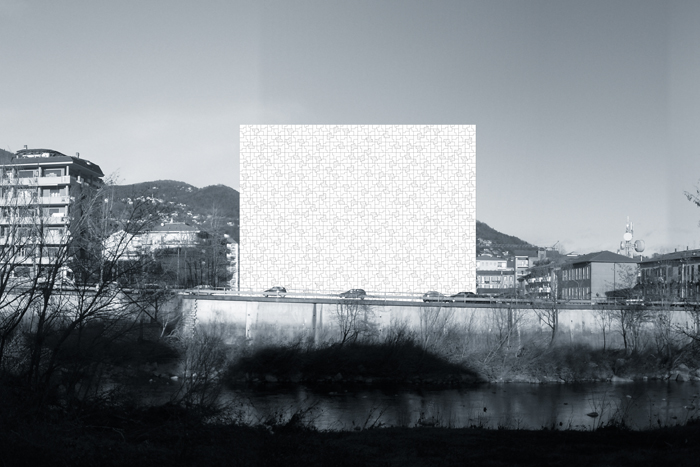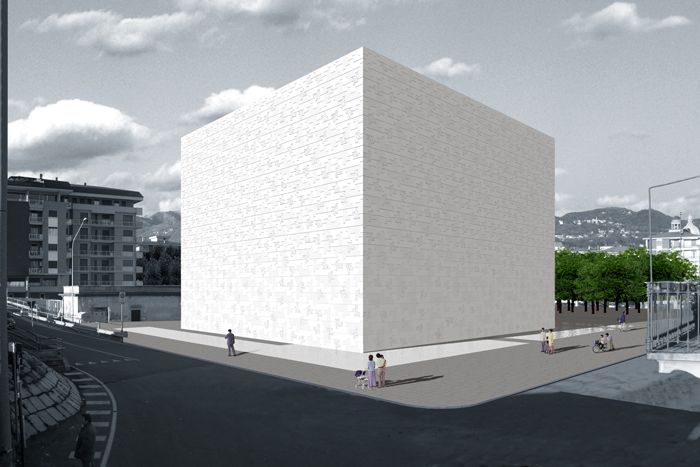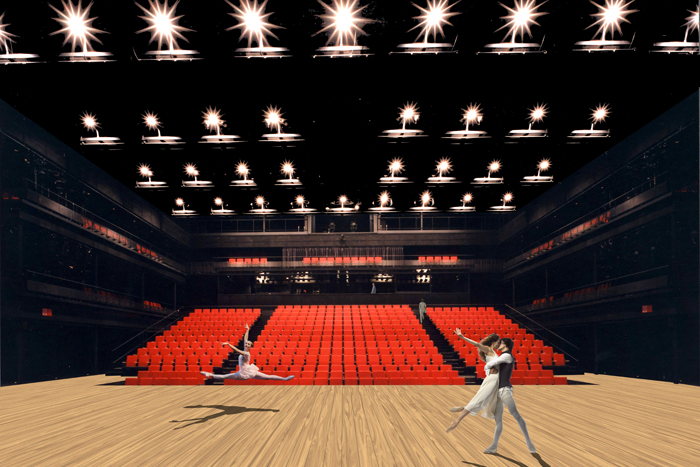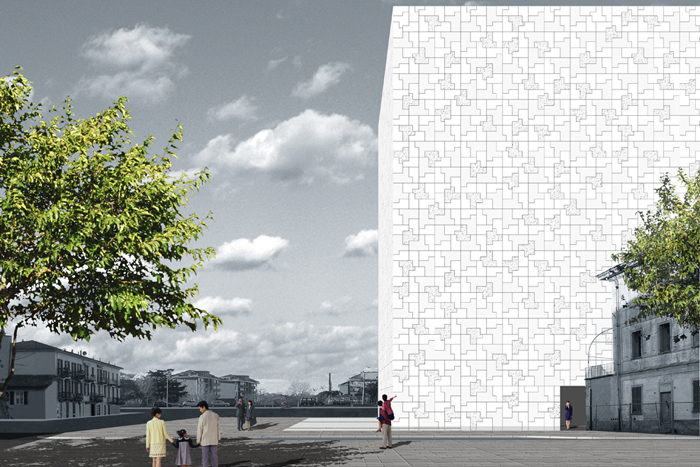



Verbania’s Theater
project
Verbania New Opera Hall
location
Verbania (VB)
program
opera theatre and concert hall
client
City of Verbania
competition
2007
project
Arata Isozaki, Andrea Maffei
design team
Hidenari Arai, Takeshi Miura, Kenji Yatsu, Rawad Choubassi, Simone Utzeri, Filippo Biagi, Atsuko Suzuki
associate
Stefano Tozzi, M+T & Partners
structure
ing. Mutsuro Sasaki, SAPS Tokyo
plants
Hilson Moran Italia, Milano
project
Verbania New Opera Hall
location
Verbania (VB)
program
opera theatre and concert hall
client
City of Verbania
competition
2007
project
Arata Isozaki, Andrea Maffei
design team
Hidenari Arai, Takeshi Miura, Kenji Yatsu, Rawad Choubassi, Simone Utzeri, Filippo Biagi, Atsuko Suzuki
associate
Stefano Tozzi, M+T & Partners
structure
ing. Mutsuro Sasaki, SAPS Tokyo
plants
Hilson Moran Italia, Milano
currently no links
currently no links
currently no publications
currently no publications
Verbania’s Theater – competition
The intervention area is located in a residential neighborhood in the center of Intra (Verbania), consisting of residential buildings and a plaza parking space. The project’ objective was to create a building to transform the existing context around. The form has been designed both to solve the functional needs of the theatre and to design an absolute form, which could become a new point of reference for citizens and a distinguishing element of the context around it. In the contemporary city, the buildings always led to similar mixed contexts in which we find no evidence that can address the tensions and movements of the city in a specific way. The purpose of a public building as the new theater of Verbania was this: to become a coordinating element of the city and transform the context.
The shape started from these objectives, we felt it was important to establish a building of great symbolic value. The choice of form has been directed on the cube to be able to condense the maximum performance of the theater inside a symbolic monument of great renewal. Like the pyramids, a large cubic volume evokes a basic geometric shape that exceeds any historical bond and style, becoming a fascinating meta-physics form.
The cube contains a theater for opera and concerts with 500 seats, with its tower, a cinema hall with 200 seats and space for offices, dressing rooms, storage-related as required by the regulations. A shallow water space around the cube is designed to separate it from surrounding streets and isolate it in a metaphysical and absolute atmosphere, due to the reflections of the water.
The existing old Chamber of Labour building, bound by the Superintendent, is tangential to the pools of water and becomes a must for anyone wishing to enter in the theatre. This emphasizes the value of the small building, placing it at the centre of attention and can be obtained by a simple restoration without any change.
On the ground floor of the exsisting Chamber of Labour is the bookshop and on the upper floors a restaurant and service areas (kitchens, locker rooms). Keeping the building independent from the theater, the restaurant will be open every day for citizens at will without depending by the new system.
After crossing the old building, the viewer accesses through a square outside the main entrance of the theater, housed in an horizontal cut at the base of the cube.
The main auditorium space entry consists of a foyer also used for exhibition space, to combine the two functions and give a special character input. As you enter you will find to be in the middle of an exhibition, and this will create a direct link of communication between the City and citizens. The exhibitions will not remain isolated and limited to a small group of visitors, but will become engaging the public in the theatre. The foyer leads directly to a 500-seat auditorium with the stage located at the same level of the ground floor. This can save a lot of stairs of security because the public will be able to run outside with a short trip in case of fire. This location also provides access directly by the truck to the stage to load or unload the scenes of the opera easily. The auditorium consists of a simple audience inclined to give the best possible visibility curve and a small upper balcony. The seats are set up on various steel structures, which can be removed and taken to an underground storage with a technique of air bearings provided at their base. The orchestra pit also serves as a freight elevator to bring the seats in the stores. This solution allows the hall to offer itself with a variety of configurations, from classical to big empty room with no chairs for various uses, one with a central stage and many others. The flexibility of use of the hall allows different directors to use the system for various forms of theatrical experimentation and the Municipality of Verbania can use for public events of different kinds. A sliding wall is separating the auditorium from the exhibition foyer. If it would be fully open, the space of the main hall can be combined with the input and transform the room again in a new different way. The audience will need just to walk into the hall, such as political conventions or for small local fairs. The search for flexibility is also in the stage with a proscenium provided with mobile tents. It is preferred to avoid a fixed proscenium walls in order not to limit the stage, but to provide a completely open system that can build up the proscenium, or even make it disappear depending on the representations.
The project’ objective was to create a hall that would allow the different kinds of representation and new forms of theatrical research. The finishes are designed very simple to not interfere with the technical use of the hall and without decorative details, but only aimed at the viewer’s comfort and overall acoustics. The foyer is repeated in the two upper floors and become a lounge / bar for refreshments after the show on the second floor. The dressing rooms, workshop and rehearsal room are set on the third floor, between the main hall and the smaller one on the fourth floor.
The small hall with 200 seats is designed for film screenings and artistic and cultural manifestations of various kinds. The back of the stage is located on the tower of the great hall to optimize the use of space. The two rooms are overlapping, intersecting each other, and create a single cubic volume. The auditorium was designed for maximum visibility from the seating to the stage. On the top of the halls we have planned spaces for projection room, direction room and control room. The interior of the room were designed with the use of simple coverings, especially for the acoustics performance of the hall.
On the top floor we locate office spaces of the theatre and plant rooms, divided by small openings that bring natural light to the offices and allow the ventilation of rooms.
The outer material of the cube is designed in white marble from Montorfano, typical local white stone to recall the use of local materials familiar to the citizens. The design of the facade is based on the aggregation of three basic shapes which are composed in various ways, based on Robert Ammann fractal calculations. The three shapes have three different finishes: smooth matte, glossy and smooth “split”, which emphasizes the rock strata. The articulation of the same material in different shapes allows its interpretation in various ways of use.
Verbania’s Theater – competition
The intervention area is located in a residential neighborhood in the center of Intra (Verbania), consisting of residential buildings and a plaza parking space. The project’ objective was to create a building to transform the existing context around. The form has been designed both to solve the functional needs of the theatre and to design an absolute form, which could become a new point of reference for citizens and a distinguishing element of the context around it. In the contemporary city, the buildings always led to similar mixed contexts in which we find no evidence that can address the tensions and movements of the city in a specific way. The purpose of a public building as the new theater of Verbania was this: to become a coordinating element of the city and transform the context.
The shape started from these objectives, we felt it was important to establish a building of great symbolic value. The choice of form has been directed on the cube to be able to condense the maximum performance of the theater inside a symbolic monument of great renewal. Like the pyramids, a large cubic volume evokes a basic geometric shape that exceeds any historical bond and style, becoming a fascinating meta-physics form.
The cube contains a theater for opera and concerts with 500 seats, with its tower, a cinema hall with 200 seats and space for offices, dressing rooms, storage-related as required by the regulations. A shallow water space around the cube is designed to separate it from surrounding streets and isolate it in a metaphysical and absolute atmosphere, due to the reflections of the water.
The existing old Chamber of Labour building, bound by the Superintendent, is tangential to the pools of water and becomes a must for anyone wishing to enter in the theatre. This emphasizes the value of the small building, placing it at the centre of attention and can be obtained by a simple restoration without any change.
On the ground floor of the exsisting Chamber of Labour is the bookshop and on the upper floors a restaurant and service areas (kitchens, locker rooms). Keeping the building independent from the theater, the restaurant will be open every day for citizens at will without depending by the new system.
After crossing the old building, the viewer accesses through a square outside the main entrance of the theater, housed in an horizontal cut at the base of the cube.
The main auditorium space entry consists of a foyer also used for exhibition space, to combine the two functions and give a special character input. As you enter you will find to be in the middle of an exhibition, and this will create a direct link of communication between the City and citizens. The exhibitions will not remain isolated and limited to a small group of visitors, but will become engaging the public in the theatre. The foyer leads directly to a 500-seat auditorium with the stage located at the same level of the ground floor. This can save a lot of stairs of security because the public will be able to run outside with a short trip in case of fire. This location also provides access directly by the truck to the stage to load or unload the scenes of the opera easily. The auditorium consists of a simple audience inclined to give the best possible visibility curve and a small upper balcony. The seats are set up on various steel structures, which can be removed and taken to an underground storage with a technique of air bearings provided at their base. The orchestra pit also serves as a freight elevator to bring the seats in the stores. This solution allows the hall to offer itself with a variety of configurations, from classical to big empty room with no chairs for various uses, one with a central stage and many others. The flexibility of use of the hall allows different directors to use the system for various forms of theatrical experimentation and the Municipality of Verbania can use for public events of different kinds. A sliding wall is separating the auditorium from the exhibition foyer. If it would be fully open, the space of the main hall can be combined with the input and transform the room again in a new different way. The audience will need just to walk into the hall, such as political conventions or for small local fairs. The search for flexibility is also in the stage with a proscenium provided with mobile tents. It is preferred to avoid a fixed proscenium walls in order not to limit the stage, but to provide a completely open system that can build up the proscenium, or even make it disappear depending on the representations.
The project’ objective was to create a hall that would allow the different kinds of representation and new forms of theatrical research. The finishes are designed very simple to not interfere with the technical use of the hall and without decorative details, but only aimed at the viewer’s comfort and overall acoustics. The foyer is repeated in the two upper floors and become a lounge / bar for refreshments after the show on the second floor. The dressing rooms, workshop and rehearsal room are set on the third floor, between the main hall and the smaller one on the fourth floor.
The small hall with 200 seats is designed for film screenings and artistic and cultural manifestations of various kinds. The back of the stage is located on the tower of the great hall to optimize the use of space. The two rooms are overlapping, intersecting each other, and create a single cubic volume. The auditorium was designed for maximum visibility from the seating to the stage. On the top of the halls we have planned spaces for projection room, direction room and control room. The interior of the room were designed with the use of simple coverings, especially for the acoustics performance of the hall.
On the top floor we locate office spaces of the theatre and plant rooms, divided by small openings that bring natural light to the offices and allow the ventilation of rooms.
The outer material of the cube is designed in white marble from Montorfano, typical local white stone to recall the use of local materials familiar to the citizens. The design of the facade is based on the aggregation of three basic shapes which are composed in various ways, based on Robert Ammann fractal calculations. The three shapes have three different finishes: smooth matte, glossy and smooth “split”, which emphasizes the rock strata. The articulation of the same material in different shapes allows its interpretation in various ways of use.






